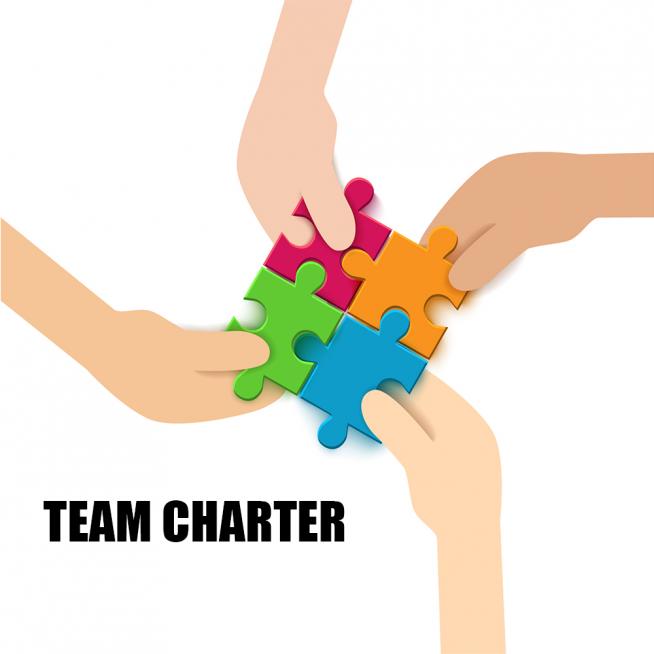Team Charter

What is this?
Teams are one of the main assets of any organization. Imagine people in a team working in different directions with different expectations, unable to work in harmony towards clear objectives. The results may not be aligned. The team charter acts as a roadmap for how the team should work together, empowering people to act towards a shared vision.
The tool is a written document of 1-3 pages which defines the purpose, mission of the team and how to accomplish it. The document also includes goals and objectives, roles and responsibilities, resources, authorities and ways of communication.
When and why is this used?
The team charter is used at the beginning of any team formation to set things right from the start. Use it when you want to set clear and tangible expectations for your team. The tool is necessary for drawing the general outlines of the focus and direction of a team. Getting back to it every now and then can help you and your team avoid a lot of conflicts that occur because of unclear roles or objectives.
How is this tool used?
The charter can be created by the managers and presented to the team or created by the whole team together. Download our template and follow the steps below to come up with your team charter.
Step 1 (Define the team purpose):
The team purpose represents an introduction to the whole document. It is written in 2-3 sentences that briefly describe why the team was formed in the beginning and what task are they trying to accomplish.
For example, “This team has been formed to complete the market research assignment as a marketing department function. Its overall objective is to forecast the market’s needs and illustrate the customer requirements”. The following questions can help you define your team purpose: Why were these people hired? Why is this team important? What is their expected outcome or delivery?
Step 2 (Set the team’s objectives):
Now, think of the objectives that must be achieved to fulfil that purpose. Make sure you write down a number of clear SMART ( specific, measurable, attainable, relevant, and time bounded) objectives to be able to assess and measure the progress of your team results. One of the customer service team objectives will be for example: to increase customer satisfaction by 30% within the next 9 months.
Step 3 (Determine the roles and responsibilities):
You look at your mission and objectives and determine what are the needed roles and responsibilities. Afterwards, you assign every team member to a certain role. While writing the needed roles, try to answer: Who will be responsible for what? What are the key deliverables of every member? Who is the team leader? and what are the empty vacancies?
Step 4 (List the available resources):
This section includes the available resources for the team to achieve its mission and objectives. The supporting resources include budget, training, time, equipment and could also include people who are not team members but could add to the team (e.g.: mentors). As an example, a team’s resources could be a $1000 travel budget or the availability of a certain software.
Step 5 (Write down the operations guideline):
The operation guideline will explain how the team will work on day-to-day activities. You could write it in brief bullet or divide it into sections and elaborate in every section. The guideline includes the organization’s code of ethics, meeting guidelines, decision-making process, conflict resolution process and internal communication and reporting system. For example stating that the team has a weekly staff meeting on Sundays at 9:00 am and to avoid penalty one should try not to skip 2 meetings per quarter.
Hints for using this tool
After you complete the team charter, every team member should agree on all the sections of the document. Get back to the charter every now and then make sure that it is guiding you along the path of achieving the team’s mission. If not try to add more components about the topics that are still causing conflicts in your team.
Case Study
Here is a sample for the team charter of the sales team of XYZ company.
- Team Purpose: The purpose of the team is to define business prospects and approach clients for selling the company products.
- Objectives:
1. Increase company sales by 15% by the end of the year.
2. Get 50 news customers by the end of December.
- Roles and Responsibilities: The sales team will include the following roles to enhance team effectiveness:
1. A team leader who is responsible for coordinating between the management and the team.
2. Senior Sales representative responsible for attending client meetings and presenting the company product.
3. Junior Sales representative responsible for compiling proposals and approaching clients through phone calls.
- Resources: The supporting resources are a monthly coaching session with the sales director, meeting rooms, mobile phones ( with a monthly prepaid charge) and laptops for every team member.
- Operation Guideline:
1. Meetings: Team meetings are to be held on Tuesdays at the office, and the meeting agenda should be sent the day before the meeting.
2. Reporting system: A weekly report has to be sent to the team leader at the end of every week with the accomplished tasks and the coming week’s tasks.
Pros and Cons
On one hand developing a team charter will help in creating an organized work environment and avoiding conflicts between team members. On the other hand, the process of creating it is time-consuming and could require more than one meeting.






































































EgyptInnovate site is not responsible for the content of the comments